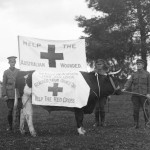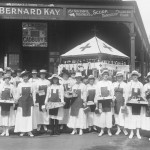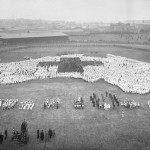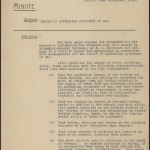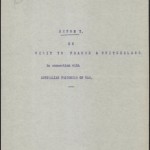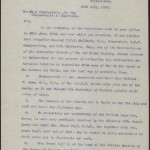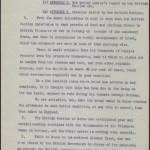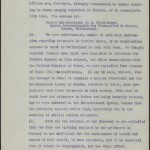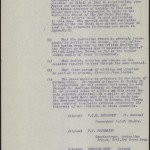Australian Red Cross Society
A necessary and essential duty- Red Cross cow, a feature of Wagga Wagga Show, 1917. From NRS 4481 MS5387.
- Red Cross stall, April 1918. From NRS 4481, image ST6216.
- School children display of Australia with Red Cross in centre, July 1915. From NRS 4481 ST5705.
Within two weeks of the outbreak of World War I the Australian Branch of the British Red Cross Society (commonly known as the Australian Red Cross Society) became established in cities and country towns across Australia.
![[Fig. 1] Helen Munro Ferguson, wife of the Governor General of Australia, 1885. From State Library Victoria, H82.1232.](http://nswanzaccentenary.records.nsw.gov.au/wp-content/uploads/2016/04/SLV-H82.1232-230x300.jpg)
On 6 August 1914 Lady Helen Munro Ferguson [Fig. 1], the wife of the Governor General of Australia, sent telegrams to the wives of the State-based Governors to appeal for help to establish the Australian Red Cross Society. She wanted the Red Cross to be a community group pitched to women, staffed by and organised by women. (1)
In New South Wales Lady Edeline Strickland agreed to become the State Divisional President. Although due to illness she may not have made a contribution on a daily basis, Lady Edeline still supported the ideal, as did the Lady Mayoress of Sydney, Minnie Adeline Richards, in her appeal in the Sydney Morning Herald on 14 August 1914:
The Red Cross Society is urgently wanted …. [it] is welcomed as a necessary duty, the Red Cross Society is most essential, and must play an important part in the defence of our country. (2)
On 13 August 1914 the Australian Branch of the British Red Cross was formally established at a meeting at Government House in Melbourne, which would go onto to become the headquarters for the group. Lady Helen was elected to the position of President, a role she continued in until she left Australia in 1920. On 14 August the Australian Government asked the Red Cross for help in providing medical supplies. (3)
The response from the women of Australia and the general public to the establishment of the Red Cross was phenomenal. Local Red Cross groups sprung up in Westmead and Tamworth on 12 August, Goulburn on 13 August, Parramatta, Redfern and Wollongong on 14 August and Wagga Wagga on 15 August. (4) By the end of the war there were 2,200 branches across Australia, of which 623 branches were in New South Wales. (5) In terms of volunteers there were 82,000 women members and another 20,000 male members. (6) By the end of the war the Red Cross had raised nearly £5 million in Australia. (7)
![[Fig. 2] Red Cross workers at Coonamble Public School knitting and spinning, 1918. From NRS 15051.](http://nswanzaccentenary.records.nsw.gov.au/wp-content/uploads/2016/04/15051_a047_0032941-e1459732142215.jpg)
[Fig. 2] Red Cross workers at Coonamble Public School knitting and spinning, 1918. From NRS 15051.
Red Cross work
From the start of the war the Red Cross successfully sewed, knitted, fundraised and collected donations to support wounded soldiers. [Fig. 2] As the war continued Red Cross activities expanded to meet wartime demands. These new activities included the founding of the Junior Red Cross, the Wounded and Missing Enquiry Bureau, the Prisoner of War Department and the Voluntary Aid Detachments.
Junior Red Cross
In 1914 Eleanor Mackinnon founded Junior Red Cross groups in schools throughout New South Wales as a way for children to demonstrate their patriotism. The Junior Red Cross (whose members were known as “Juniors”) was extremely popular and schools such as Glencoe Public School, Tia Public School, Parramatta and Sydney Girls High Schools quickly established groups.(8) It was the Junior Red Cross that drove the knitted sock campaign, which in 1915 alone, amassed over 54,000 pairs of socks. (9) In September 1918 the NSW Minister for Education, Augustus James, assented to the Junior Red Cross being included as a ‘service activity’ within public schools. It is estimated that by August 1919 there were over 12000 Juniors in NSW. (10)
Wounded and Missing Enquiry Bureau
As news of the Gallipoli campaign filtered back to Australia, many families wanted more details about what had happened to their loved ones. In October 1915 Vera Deakin arrived in Cairo to establish the Wounded and Missing Enquiry Bureau for the Australian Red Cross.
- [Fig. 3] Relief of Australian Prisoners of War, includes Red Cross Report. From NRS 12060 [9/4724] letter 16/5171.
- [Fig. 4] Red Cross Report on visit to France and Switzerland in connection with Australian Prisoners of war. From NRS 12060 [9/4724] letter 16/5171, p.1.
- [Fig. 5] Red Cross Report on visit to France and Switzerland in connection with Australian Prisoners of war. From NRS 12060 [9/4724] letter 16/5171, p.2.
- [Fig. 6] Red Cross Report on visit to France and Switzerland in connection with Australian Prisoners of war. From NRS 12060 [9/4724] letter 16/5171, p.3.
- [Fig. 7] Red Cross Report on visit to France and Switzerland in connection with Australian Prisoners of war. From NRS 12060 [9/4724] letter 16/5171, p.4.
- [Fig. 8] Red Cross Report on visit to France and Switzerland in connection with Australian Prisoners of war. From NRS 12060 [9/4724] letter 16/5171, p.5.
- [Fig. 9] Red Cross Report on visit to France and Switzerland in connection with Australian Prisoners of war. From NRS 12060 [9/4724] letter 16/5171, p.6.
Prisoner of War Department
In June 1916 Red Cross Commissioner Frederick William Fairburn and British Brigadier-General Sellheim visited France and Switzerland to view first hand British arrangements for the supply of food and clothing to prisoners of war being held in Germany. As a result of their report [Fig. 3-9] the Australian Red Cross Society became responsible for “all duties relating to the supply of extra food and clothing required by Australian prisoners of war”. (11) By July 1916, the Prisoner of War Department, headed by Elizabeth Chomley, was established. There were 4352 Australian prisoners of war who were held in Germany, the Netherlands, Austria, Switzerland and Turkey. (12)
Voluntary Aid Detachments
In 1915 the Australian Red Cross established a new initiative, the Voluntary Aid Detachments (or VAD). The Australia-wide scheme provided basic first aid training (supplied by the St John Ambulance Service) to about 10,000 women volunteers, known as a VA. (13) After the VA had attended a first aid course and completed a month long stint at a major hospital, such as Sydney Hospital, they could begin their work. VAs could work in Red Cross convalescent and nursing homes as nursing orderlies, carrying out menial tasks such as rolling bandages, cleaning floor or feeding patients. (14) VAs also worked as unpaid helpers in places such as the Anzac Buffet in Hyde Park Sydney, the Red Cross Pickle Depot, the Red Cross Jam Factory and the Red Cross Fruit and Vegetable Depot in Sydney. In September 1916 Australian VAD workers were allowed to serve overseas for the first time. They were recognised as auxiliaries to the medical service and soon began working in military hospitals.
Post war
In 1919 Lady Helen paid tribute to the women of Australia:
Thanks to whose persistent industry, power of organisation, and generosity success has been achieved. (15)
This success was a practical contribution from the home front to meet wartime demands. Following the conclusion of the war the enormous work of the Australian Red Cross Society was recognised and the popularity of the group continued in peace time.
Further information
For more information regarding the work of the Australian Red Cross Society in NSW contact:
Australian Red Cross (New South Wales Branch)
Archives and Heritage Collection
Office staffed Tuesday 10am-3pm
Call 02 9229 4182 or 02 9229 4230
Sue Grunstein (sgrunstein@redcross.org.au)
Pam Peelgrane (ppeelgrane@redcross.org.au)
For more details regarding the Australian Red Cross Society Wounded and Missing Enquiry Bureau case files contact the Australian War Memorial. The case files have been digitised and can be searched online.
For more details regarding the Australian Red Cross Society Prisoner of War case files contact the Australian War Memorial. Australian Red Cross Prisoner of War files have not been digitised but can be viewed in the Australian War Memorial research centre.
Related
- Red Cross records in the archives
- The role of women in patriotic fundraising
- Patriotic fundraising in public schools
REFERENCES
(1) Oppenheimer, Melanie, “Lady Helen Munro Ferguson and the Australian Red Cross: Vice-regal Leader and Internationalist in the Early twentieth century”, The Australian Women’s Register, http://www.womenaustralia.info/leaders/fff/pdfs/ferguson.pdf, accessed on 30 November 2015, pp280-81.
(2) “Red Cross, Lady Mayoress’s appeal to the people”, Sydney Morning Herald, 14 August 1914, p.10, http://trove.nla.gov.au/ndp/del/article/15529609, accessed 22 Dec 2015.
(3) Suter, Keith, “Australian Red Cross Society”, Global Directions, http://www.global-directions.com/Articles/Peace%20and%20Conflict/AustralianRedCross.pdf, accessed on 13 January 2016.
(4) Willis, Ian, “Doing their bit: The Red Cross on the New South Wales Homefront during the First World War”, History: Magazine of the Royal Australian Historical Society, March 2015, No. 123, pp 3-5.
(5) Scott, Ernest, Official History of Australia in the War of 1914-18, Vol. XI, 7th Ed., 1941 (Ch XXI), https://www.awm.gov.au/collection/RCDIG1069950/, accessed 30 November 2015, p.703.
(6) Ibid.
(7) Oppenheimer, “Lady Helen”, p.282.
(8) Campbell, Annie, “…thousands of tiny fingers moving – The beginning of the Junior Red Cross movement in New South Wales, 1914-1928”, Journal of the Royal Australian Historical Society, Vol. 90, Issue 2, December 2004.
(9) Oppenheimer, Melanie, Australian Women and War, Canberra, Department of Veterans’ Affairs, 2008, p.42; Campbell, p.188.
(10) Campbell, p.191.
(11) State Archives New South Wales: Premier’s Department; NRS 12060, Letters received [9/4724] letter 16/5171.
(12) Scott, p.707.
(13) Ibid, p.712.
(14) Oppenheimer, Melanie, Red Cross VAs: A History of the VAD Movement in NSW, Walcha, Ohio Productions, 1999, p.149.
(15) Scott, p.713.

